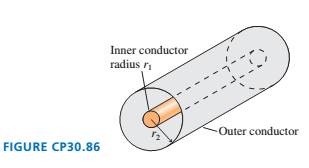
Concept explainers
High-frequency signals are often transmitted along a coaxial cable, such as the one shown in FIGURE CP3O.86. For example, the cable TV hookup coming into your home is a coaxial cable. The signal is carried on a wire of radius
a. Find an expression for the inductance per meter of a coaxial cable. To do so, consider the flux through a rectangle of length l that spans the gap between the inner and outer conductors.
b. Evaluate the inductance per meter of a cable having

Want to see the full answer?
Check out a sample textbook solution
Chapter 30 Solutions
Physics for Scientists and Engineers: A Strategic Approach with Modern Physics, Books a la Carte Edition; Student Workbook for Physics for Scientists ... eText -- ValuePack Access Card (4th Edition)
- Give an example of friction speeding up an object.arrow_forwardWhich is the higher temperature? (Assume temperatures to be exact numbers.) (a) 272°C or 272°F? 272°C 272°F They are the same temperature. (b) 200°C or 368°F? 200°C 368°F They are the same temperature.arrow_forwardWhat is the direction of a force vector given by ~v = −6Nˆi − 8Nˆj?arrow_forward
- What can be said of the position vector of an object far from any influences on its motion?arrow_forward་ Consider a ball sliding down a ramp as shown above. The ball is already in motion at the position 1. Which direction best approximates the direction of acceleration vector a when the object is at position 2?arrow_forwardPlease solve and answer the question correctly please. Thank you!!arrow_forward
- Please solve and answer the problem correctly please. Thank you!!arrow_forwardPlease solve and answer the problem correctly please.Thank you!!arrow_forwardProblem Eight. A snowmobile is originally at the point with position vector 31.1 m at 95.5° counterclockwise from the x-axis, moving with velocity 4.89 m/s at 40.0°. It moves with constant acceleration 1.73 m/s² at 200°. After 5.00 s have elapsed, find the following. 9.) The velocity vector in m/s. (A)=-4.38+0.185ĵ (D) = 0.185 +4.38ĵ (B)=0.1851-4.38ĵ (E) = 4.38 +0.185ĵ (C) v=-0.1851-4.38ĵ (A)=-39.3-4.30ĵ 10.) The final position vector in meters. (B)=39.3-4.30ĵ (C) = -4.61 +39.3ĵ (D) = 39.31 +4.30ĵ (E) = 4.30 +39.3ĵarrow_forward
 Physics for Scientists and Engineers: Foundations...PhysicsISBN:9781133939146Author:Katz, Debora M.Publisher:Cengage Learning
Physics for Scientists and Engineers: Foundations...PhysicsISBN:9781133939146Author:Katz, Debora M.Publisher:Cengage Learning College PhysicsPhysicsISBN:9781938168000Author:Paul Peter Urone, Roger HinrichsPublisher:OpenStax College
College PhysicsPhysicsISBN:9781938168000Author:Paul Peter Urone, Roger HinrichsPublisher:OpenStax College
 Principles of Physics: A Calculus-Based TextPhysicsISBN:9781133104261Author:Raymond A. Serway, John W. JewettPublisher:Cengage Learning
Principles of Physics: A Calculus-Based TextPhysicsISBN:9781133104261Author:Raymond A. Serway, John W. JewettPublisher:Cengage Learning An Introduction to Physical SciencePhysicsISBN:9781305079137Author:James Shipman, Jerry D. Wilson, Charles A. Higgins, Omar TorresPublisher:Cengage Learning
An Introduction to Physical SciencePhysicsISBN:9781305079137Author:James Shipman, Jerry D. Wilson, Charles A. Higgins, Omar TorresPublisher:Cengage Learning Glencoe Physics: Principles and Problems, Student...PhysicsISBN:9780078807213Author:Paul W. ZitzewitzPublisher:Glencoe/McGraw-Hill
Glencoe Physics: Principles and Problems, Student...PhysicsISBN:9780078807213Author:Paul W. ZitzewitzPublisher:Glencoe/McGraw-Hill





